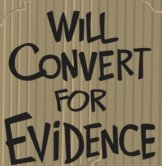|
Lets chew on some of these points about cremations.....finishing up
reading the book Dissecting The Holocaust
According to a November 27, 1986, report of the New Delhi Schenectady
Gazette, cremations and the consumption of wood involved therein (due
to the lack of corpses that will burn by themselves) are a serious
concern for the inhabitants of India, since entire forests have been
cut down over time for just this purpose. According to this report,
the daily incineration of 21,000 bodies requires 6,433 metric tons of
wood, i.e., 675 lbs. per body. In applying these conditions to
Treblinka, we shall simplify the matter somewhat by ignoring the
problems involved in the prior exhumation of the bodies; let it
suffice to consider only one unreality, namely the incineration of
the bodies. To forestall objections of any kind, we shall reduce the
consumption of wood for mass cremations from 675 lbs. to 440 lbs. per
body.110 From various eyewitness accounts it follows that the
cremation process lasted until early August, a total of about 185
days. This means that a minimum of 4,700 bodies had to be cremated
every day, requiring 950 metric tons of dry wood daily. The
engineering handbook Hütte indicates a volume of 74.15 cu.ft. per
metric ton for spruce wood,111 and of 109.5 cu.ft. per metric ton for
spruce wood fire logs.112 This means that the volume of the wood
needed in Treblinka daily for incinerating the corpses would have
been about 104,000 cu.ft. This volume is perhaps easier to grasp when
visualized as a stack 3 ft. high, 3 ft. wide and about 1.75 miles
long. Every day! The cremation gratings, described by Warszawski as
measuring 13 ft. × 33 ft. and with 1.5 ft. elevation above the
ground, had a spatial volume of approximately 650 cu.ft. underneath
the grating. To ensure that the firewood would receive enough draft
(oxygen), a maximum of 530 cu.ft. could have been placed underneath.
This quantity corresponds to a net weight of 10,600 lbs. and would
have sufficed for cremating 24 (twenty-four!) bodies. If one assumes
that, in this case, the complete incineration of the bodies took only
2 hours (which, however, is far too short to be realistic), then even
cremating ‘round-the-clock’ would have disposed of 288 bodies at
most.
The high piling-up of bodies on the grating, as it is described by
witnesses, would have brought nothing but disadvantages, if only due
to the inhibited access granted the flames. But if 4,700 bodies had
to be burned every day, this would have required more than 16
gratings as described above, with a total surface area of 6,890
sq.ft. Stoking the cremation sites with wood, and removing the ashes
and skeletons, are elements which have been ignored to date. Given
the heat of the fire under the gratings and the stench of the burning
bodies, it would have been impossible to perform these necessary
tasks while the fire was burning. It is thus safe to say that
continuous cremation in the manner described, and using the burning
sites described by the witnesses, would not have been possible.
Burning the 4,700 bodies would have required at least twice the
number of gratings. With reference to the number of bodies to be
incinerated, we still need to examine the source, processing and
transportation of the needed quantities of firewood. The total
cremation process in Treblinka would have required 430 million
pounds, or 195,000 metric tons, of air-dried (seasoned) wood. Due to
the short notice and brief time that Himmler allegedly allotted for
this process, such a large quantity of air-dried wood would certainly
have been impossible to get, which is why only fresh (“green”)
wood of lower calorific value would have been available. The
calorific value of seasoned wood is 3,600 kcal/kg, whereas that of
green wood is only 2,000 kcal/kg.113 Therefore the total required
quantity of wood would have increased to 351,000 metric tons, and the
daily requirement of green wood was thus approximately 1,900 metric
tons.
How much wood would a woodchuck chuck
If a woodchuck could chuck wood
Assuming medium-sized trees of 1 cord volume and 1,500 lbs., the
total number of trees needed comes to roughly 515,000. There were two
options for obtaining the required quantity of wood: either there was
a large forested area near the camp where the demand for firewood
could be met, and whence the wood would then be transported to the
camp with suitable vehicles, or the wood had to be brought in from
other areas by rail. Let us suppose for the moment that the wood
supply was nearby. Assuming that a 15-ton truck can make 3 runs
daily, allowing for loading and unloading of the truck, then 126
trips would need to be made daily, using some 42 trucks. None of the
eyewitness statements indicate the presence of such a fleet of
trucks. The same goes for the labor force required for the daily
felling, limbing, sawing and splitting as well as loading and
unloading of 2,800 trees. If, given the primitive conditions that
prevailed, we assume that two man could have processed - that is,
felled, limbed, sawed and split - one tree per day (an utter
illusion), then the lumberjacks would clearly have had to number at
least 5,600. To give an idea of how large a forest would need to be
in order to supply such vast quantities of wood, let us assume a
yield of 325 cord per acre, which for 515,000 trees would require a
forest of 1,590 acres, or just short of 2.5 square miles. To put it
more graphically, such a forest would have been 2.5 miles long and 1
mile wide. Is it really conceivable that the witnesses and the local
residents could have failed to notice such a large deforested area?
The site would still be apparent today. If one proceeds instead on
the assumption that the quantity of wood needed would not have been
available locally, then it would have had to be brought in from
elsewhere, for example in the form of large fire logs, in rail
wagons. If one performs the corresponding calculations for this
scenario, then a freight train of 63 cars of 30 metric tons each
would have had to be unloaded in the camp every day - a total of
185 freight trains. In the end the total length of the trains would
have reached 116 km, or 72 miles. This begs the question: where are
the pertinent Reichsbahn (German Railway) documents about these
enormous wood transports? The authorities and offices in question
would hardly have dispensed with payment and not submitted their
accounts. Regarding the claim that the 875,000 corpses were
eliminated completely with out any trace, we must consider the
quantities of ashes that remain. The quantities of wood ashes are
considerable, and vary with the type of wood. We shall postulate the
low value of 6.6 lbs. per ton of dry wood.112 The wood ashes
remaining would then have weighed approximately 1,000 metric tons;
the equivalent of the payload of 100 10-ton trucks. The ash content
of a human body makes up about 5.6% of the body’s weight;114 given
a 132 lb. body, this comes to 7.3 lbs. The ashes from the 875,000
burned bodies would thus have weighed 6,387,500 lbs. The total
quantity of ashes - wood ashes plus human ashes - would therefore
have weighed almost 4,000 metric tons, or 8.6 million pounds, all of
which (according to the witnesses) were then mixed with the soil and
thrown back into the pits.115 Even if this quantity of ash had been
mixed with the roughly 3.53 million cubic feet of soil excavated from
the burial pits, it would be easy to find evidence for human remains
of the quantity alleged by the witnesses.
It must also be noted that in the incineration of corpses under the
conditions specified by the witnesses, the bones would not have
turned to ash, but would have remained as bones. The witnesses have
described how the skeletal remains of the corpses were broken up, and
screened and sifted over and over again to ensure that no evidence
would remain. Given the primitive equipment described by the
witnesses - wooden rollers and thin sheets of metal for crushing
the bones - it might have been possible for a man to break up and
sift two skeletons per hour in the manner specified. Thus, if one
Jewish laborer had pulverized 20 skeletons per day, 240 Jewish
laborers would have been needed for this task alone. Adding up the
required personnel - 5,600 Jewish laborers for obtaining the wood,
240 for pulverizing the bones, and 150 to stoke the fire sites -
fully 6,000 Jewish workers were needed to complete all the required
tasks in a solid seven-day work week. Additionally, further hundreds
of Jewish workers would have been needed to carry out various other
tasks reported by witnesses: excavating and filling trenches,
camouflage activities, sorting the valuables of the murdered Jews,
cutting the hair and extracting the gold teeth of the victims,
rendering services to the SS, administration, rations and supplies
for the camp, etc. There would also have to have been reserve labor
standing by at all times. Thus the camp would have had to have a
permanent workforce of at least 8,000. This number stands in glaring
contrast to the mere 700 Jewish laborers attested to for
Treblinka.116 And finally, we must note that the teeth of the
supposed victims could not have been destroyed by the primitive
methods attested to.117 Even if each of the alleged victims had only
20 of the usual 32 teeth left at the time he or she died, there would
have been at least 17.5 million teeth to be disposed of at Treblinka.
This means that we should still be able to find some 5 teeth per
cubic foot of the 3.53 million cu.ft. of material excavated at the
alleged site of the crime. All these calculations are based on the
number of victims (875,000) specified by the Jerusalem court. If, on
the other hand, one were to postulate the 3 million Treblinka victims
alleged by Grossmann and others, then the data ascertained in the
previous must be multiplied by a factor of 3.5, meaning: 6,650 metric
tons of wood daily to cremate the corpses; a total of approximately
1,200,000 tons of firewood, i.e., almost two million trees, for whose
transport trains totaling about 252 miles would have been required.
The area of the forest thus required amounts to 9 square miles. There
would have been roughly 13,700 tons of ashes to hide, containing at
least 60 million teeth. And where on earth were the 20,000 Jewish
laborers needed to do all the work involved?
Corpses that self-ignite and burn without fuel are extremely rare in nature,
one in twenty gazillion corpses.
Cremation facts for the Auschwitz camps
There were 52 total crematories in the two main camps....Around
40 were operating at the time so my figures have to be based on that.
They probably operated 12 hrs per day they can't be run 24 hrs. The life
of a crematory is 2000-3000 bodies until it has to be rebuilt.
There were NO crematories that were rebuilt in th Auschwitz camp.
So using the high figure of 3000 bodies for usefulness....there
couldn't have been no more than 150,000 bodies cremated in the camps.
The Jews claim officially around 4000+ were cremated per day. Complete
nonsense! On a good day they might have cremated 500-800 bodies, again
all depending on actual time it took to cremate one body and how long the
crematory was working. It's hard to get exact figures for any
of this stuff.
This appears to be the transcript of an inquiring person
questioning an AI Chatbot about historical matters. Step by step
the person asks Chatbot for factual answers to probing
questions. The answers are essentially numeric calculations
based on known data for bodily cremation rates, historic
architecture, (alleged) demographics, and (alleged) historical
narratives.
Only one conclusion may be derived from this conversation:
Chatbot is Antisemitic! Chatbot is a Holocaust Denier! Reprogram
Chatbot!
However, I have some problems with the math. If it takes 2 hours
to cremate one body, then it takes 2.2 million hours to cremate
1.1 million bodies. How many hours are in 78 years? 78 x 365 x
24 = 683,280. That's more than 3 times short of 2.2 million
hours. So we have to multiply 78 years by 3.22 to know the
number of years for 4 crematoria working 24/365 to cremate 1.1
million bodies. That's over 250 years.
Was Chatbot wrong? Inconceivable. Was it trying to be kind and
soften the distress of holocaust promoters and believers? Not
likely. Chatbots do not have such emotions, only artificial
displays of emotion. It's more likely this entire transcript
is fabricated by human agency only.
I originally saw this conversation on The Realist Report
Telegram site. It came there from the Fashposting Telegram site
(5500 subscribers). Fashposting states:
"Disclaimer: To any federal and/or law enforcement agencies
reading this: every post on this channel is purely satirical. In
no way is any post meant to incite violence. This channel does
not condone violence or criminal activity of any kind."
Perhaps this Chabot convo is purely satirical. Nevertheless it
makes a good point. Too bad it gets the math wrong by a factor
of 3. Accuracy would have been it its favor in two ways,
credibility and incredulity.
Jewish Virtual Library may be smarter than Chatbot. It states:
"According to calculations by the German authorities, 340
corpses could be burned every 24 hours after the installation of
the three furnaces."
Math: 24 x 60 = 1440 minutes. 340/1440 = .25 bodies/minute
(approx.)
That is one corpse every 4 minutes. And this was only for 3
years August 15, 1940 until July 1943.
This was in Crematorium 1 only.
JVL states: "The SS used Zyklon B to kill thousands of Jews
upon arrival..." This is far too vague. If Crematorium 1
operated 24/365 for about 3 years, 365 x 3 =1000 days approx.
1000 x 24 x 60 =1.44 million minutes. 1.44 million minutes to
cremate bodies at a rate of 4 minutes/body = 360,000 bodies! Why
didn't JVL say so, instead of a vague "thousands of Jews?"
It probably didn't bother to do the math.
For Crematorium 2, JVL states:
"Several hundred thousand Jewish men, women and children were
murdered here with poison gas, and their bodies burned. The
bodies of Jewish and non-Jewish prisoners who died in the
concentration camp were also burned here. According to
calculations by the German authorities, 1,440 corpses could be
burned in this crematorium every 24 hours. According to the
testimony of former prisoners, the figure was higher."
Testimony of former prisoners is worthless, so let's get real.
Math again: Convert 24 hours to minutes. 24 hours x 60 minutes =
1440 minutes. With 1440 bodies every 1440 minutes, this math is
easy! It took 1 minute to cremate each body. LOL! Those clever
Germans has some kind of flash-frying technology. Chatbot was
off by a factor of 120.
So how many years to cremate "several hundred thousand"
(let's be generous at 300,000) bodies in Crematorium 2?
Answer: 300,000 minutes!
300,000/60/24 = 208 days. Less than 7 months. Here Chatbot
underestimated the pace of cremation by around 150 times!
That's using Chatbot's falsely lower number of 78 years. If
we use the accurate number of 250 years, Chatbot was off by a
factor of 483.
Somebody is lying here. Jewish Virtual Library most likely
started with a goal of 1 body per minute, and calculated
backward. Pernicious war propaganda and atrocity stories
demonizing evil Germans with bad math. Chatbot is most likely a
living human being writing up a fictitious conversation and
getting the math wrong in the opposite direction,
underestimating the years it would take to cremate so many
bodies.
Verdict: Chatbot wins, more than even it realizes.
|

 hjw2001@gmail.com
hjw2001@gmail.com





